The Kaveri Refresh 'Godavari' Review: Testing AMD's A10-7870K
by Ian Cutress on June 1, 2015 11:59 AM ESTOffice Performance
The dynamics of CPU Turbo modes, both Intel and AMD, can cause concern during environments with a variable threaded workload. There is also an added issue of the motherboard remaining consistent, depending on how the motherboard manufacturer wants to add in their own boosting technologies over the ones that Intel would prefer they used. In order to remain consistent, we implement an OS-level unique high performance mode on all the CPUs we test which should override any motherboard manufacturer performance mode.
All of our benchmark results can also be found in our benchmark engine, Bench.
Dolphin Benchmark: link
Many emulators are often bound by single thread CPU performance, and general reports tended to suggest that Haswell provided a significant boost to emulator performance. This benchmark runs a Wii program that raytraces a complex 3D scene inside the Dolphin Wii emulator. Performance on this benchmark is a good proxy of the speed of Dolphin CPU emulation, which is an intensive single core task using most aspects of a CPU. Results are given in minutes, where the Wii itself scores 17.53 minutes.
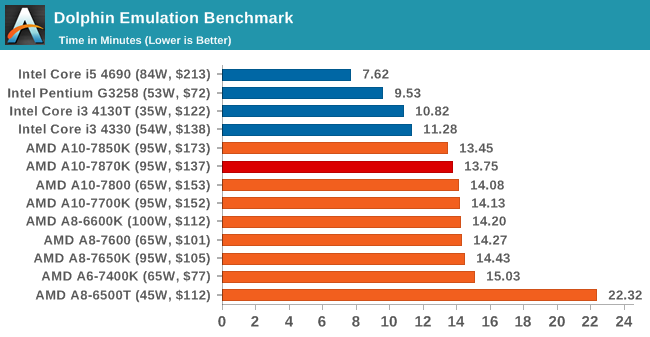
WinRAR 5.0.1: link
Our WinRAR test from 2013 is updated to the latest version of WinRAR at the start of 2014. We compress a set of 2867 files across 320 folders totaling 1.52 GB in size – 95% of these files are small typical website files, and the rest (90% of the size) are small 30 second 720p videos.
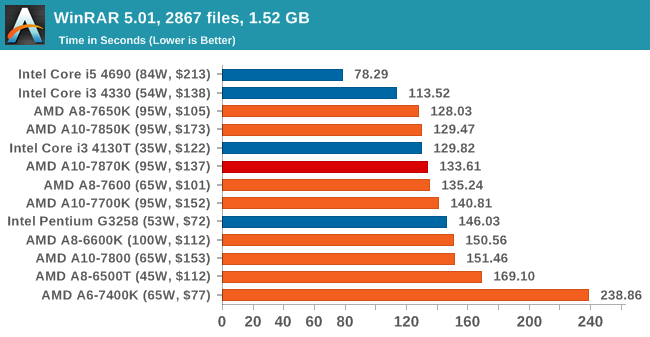
3D Particle Movement
3DPM is a self-penned benchmark, taking basic 3D movement algorithms used in Brownian Motion simulations and testing them for speed. High floating point performance, MHz and IPC wins in the single thread version, whereas the multithread version has to handle the threads and loves more cores.
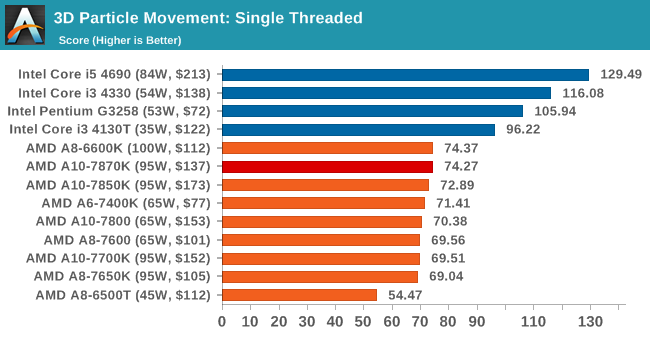
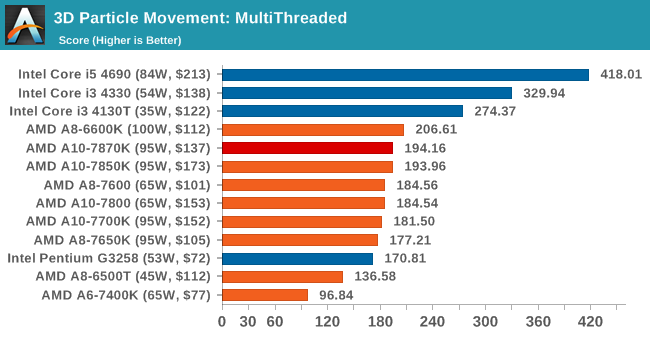
FastStone Image Viewer 4.9
FastStone is the program I use to perform quick or bulk actions on images, such as resizing, adjusting for color and cropping. In our test we take a series of 170 images in various sizes and formats and convert them all into 640x480 .gif files, maintaining the aspect ratio. FastStone does not use multithreading for this test, and results are given in seconds.
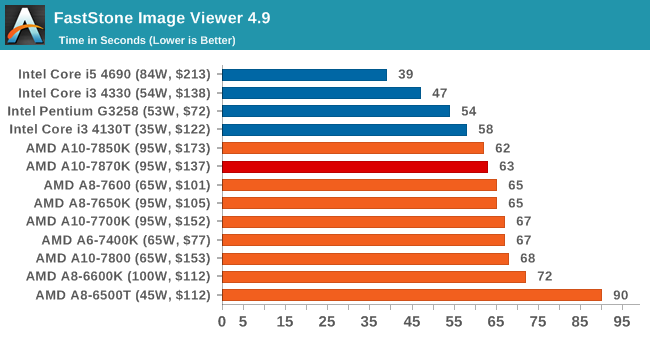
Web Benchmarks
On the lower end processors, general usability is a big factor of experience, especially as we move into the HTML5 era of web browsing. For our web benchmarks, we take four well known tests with Chrome 35 as a consistent browser.
Sunspider 1.0.2

Mozilla Kraken 1.1
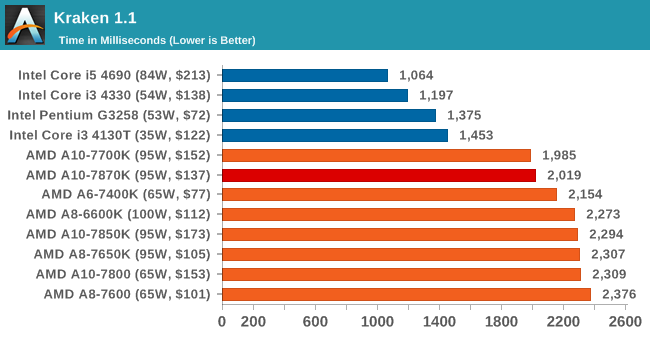
WebXPRT
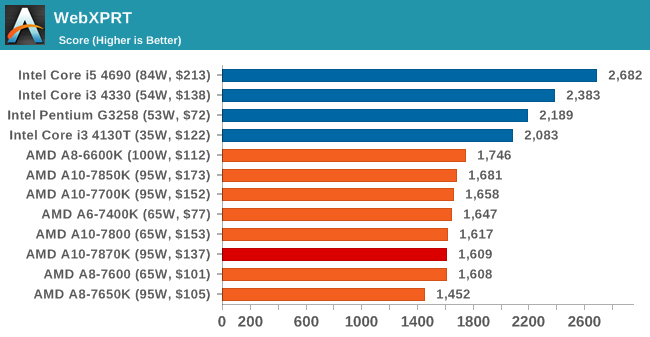
Google Octane v2
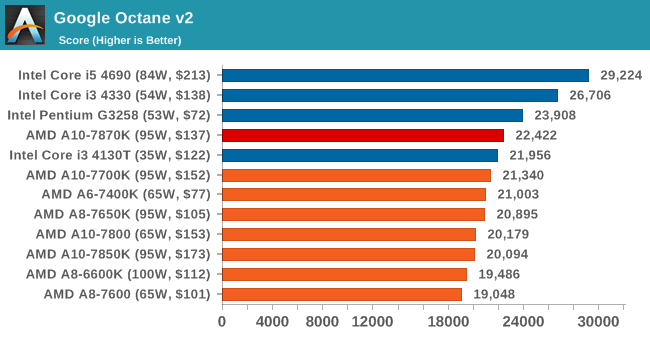










140 Comments
View All Comments
Travis26 - Tuesday, June 2, 2015 - link
AMD seems to have the stock voltages too high a lot of times. My Athlon x4 750k with default settings goes up to 1.45 V for the 4 Ghz turbo boost, but it is perfectly stable at 1.29V and possibly lower. I had to lower the voltage because the temperatures were too high under load with the stock cooler.hallstein - Monday, June 1, 2015 - link
Something is seriously wrong with these numbers. The ordering of the AMD parts seems to be effectively random in many cases. What the hell happened?And the conclusions drawn make no reference to the crazy numbers. I'm a big fan of anandtech's reporting, but I'm sorry to say this article is just about useless as is.
number99 - Monday, June 1, 2015 - link
I agree. Part of the problem may be the need for a new bios for the new cpu (it seems to be throttling), but a lot of the benches don't make sense.silverblue - Tuesday, June 2, 2015 - link
The board in question isn't the same as the one that CPU World used (ASRock FM2A88M Extreme4+). Unless AMD made a large boo-boo pre-release that would affect multiple vendors' BIOS updates, I can't see this affecting the results too much. It may be worth testing on that ASRock board to see what a patched board will do, or perhaps throwing a 7850K into the MSI board to see if the board itself is to blame. It's likely the higher Kaveri models, but the power usage looks rather off as well so it could be the board.I'm waiting on another review which can hopefully shed some light on the performance issues we've been seeing. Perhaps it was really only AT's sample that was causing issues?
Vesperan - Monday, June 1, 2015 - link
I find it interesting that even with a R9 285 or GTX 770 you are quite often GPU bound (at 1080p) rather than CPU bound. If your only concern is gaming (like mine, and likely most here) it reinforces that low(ish) end CPU + high(ish) GPU is best for price-performance. Seems odd you can have such a low performance CPU with such a high performance GPU.mikato - Wednesday, June 3, 2015 - link
Yeah this is what makes AMD chips great options for gamers right now. Very similar performance for much cheaper with a good discrete GPU, and much better performance with integrated GPU.ES_Revenge - Saturday, June 6, 2015 - link
It's not really odd at all, it's the way it has always been for *most* contemporary games and GPUs. Some games do have some 'balance' toward CPUs as well but GPU is still the major player in game performance. Three cores (remember Athlon-II X3?) or two cores plus hyper threading, and clock around 3Ghz or faster (depending on what CPU it is) is enough CPU for most modern games. And, unless you are aiming for really high framerates in SLI/Crossfire, PCI-e 1.1 x16 is also enough for single-card gaming. These things have been proven time and time again, yet lots of people like to talk about or imagine "bottlenecks" that just don't exist.You can have a R9 280X or GTX 770 on a Yorkfield C2Q and not really be too worse for wear in gaming other than high power consumption/heat, particularly if you're only looking for 60FPS. You'll still have 80-95% of the FPS performance of a modern i5 and the same GPU in most games and if that performance is otherwise in the 100s and you only need 60 Vsync, then the add'l CPU power is doing nothing for you.
Going from a C2D to a C2Q to an i7 all on the same GPU, I can tell you the biggest jump in performance in gaming, came from going from the C2D to the C2Q. Sure a Haswell i7 is going to give some better frame rates than a Clarkdale i3 and the same GPU, but it's not going to be any spectacular leap and if you're not trying to squeeze 130FPS from where you were getting 110FPS previously, you don't care about a faster CPU. And even then you are better off OCing your GPU first, again for most games.
All you really need for decent 60FPS gaming is a fast GPU(s) (fast enough for the res and settings you want to play at) and any ol CPU that is 3 cores/threads or more and a decent clock rate. Not really much more to it than that.
nofumble62 - Tuesday, June 2, 2015 - link
Does it support 4K monitor? If yes, what is the frame rate?anubis44 - Wednesday, June 3, 2015 - link
Ian is English, which means his vocabulary, even if he were only a typical Brit, is about 6 times the size of most Americans. A 'queue' is a line-up. A 'miasma' is a noxious atmosphere or influence. I often think, as a Canadian of British descent, the Americans would have been much better off in a myriad of ways if they'd simply lost the Revolutionary War. They'd likely have universal healthcare, about ~50,000 fewer gun deaths every year, and much bigger vocabularies. They'd also be able to read a grade 9 level English CPU review without having to ask 'WTF' it means.silverblue - Monday, June 8, 2015 - link
Oh, the Americans use the word 'queue', albeit spelt as 'cue', and it's seldom used.